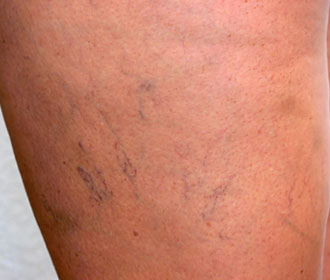Varicose Veins
 Varicose veins are an incredibly common problem in the United States, yet only a small number of people seek treatment. Not only can these leg veins be unattractive, but also extremely painful.
Varicose veins are an incredibly common problem in the United States, yet only a small number of people seek treatment. Not only can these leg veins be unattractive, but also extremely painful.
What causes varicose veins? It all comes down to blood flow. One-way valves inside your veins keep blood flowing to your heart. When the valves in your legs become weak or damaged, blood can back up and pool in your legs, causing the veins to swell. This can lead to varicose veins. If left untreated, varicose veins can progress to a more serious condition called chronic venous insufficiency (CVI), with symptoms that worsen over time.
“We work to slow the progression,” says Vascular Surgeon Dr. Jarrod Buresh, St. Luke’s Vascular Services. “This can be a lifelong problem for some patients. We work to find ways to control and treat the symptoms related to chronic venous insufficiency and varicose veins.”
What are the symptoms? According to the National Heart, Lung and Blood Institute, symptoms include:
- Large, visible veins just under the surface of your skin
- Mild swelling in ankles and feet
- Painful, achy or "heavy" legs
- Throbbing or cramping in legs
- Itchy legs, especially on the lower leg and ankle (sometimes incorrectly diagnosed as dry skin)
- Discolored skin in the area around the varicose vein
- Clusters of red veins under the surface of your skin
- Red or blue veins that form a web or tree branch pattern (spider veins)
While the condition affects both men and women, women are more likely to develop varicose veins. “For women, it can often be related to pregnancy,” says Dr. Buresh. “Pregnancy increases pelvic congestion, and increased pressures can translate down the leg.” Other risk factors for varicose veins include obesity, family history, older age, inactivity, and jobs that require standing a lot on hard surfaces.
How are varicose veins treated? Lifestyle changes such as exercise, weight loss, keeping legs elevated, and avoiding standing or sitting for long periods can help relieve symptoms. Treatment options for varicose veins and CVI include minimally invasive treatments and surgical treatments to either remove the affected veins or close them.
Before surgery can be done, most insurance companies require a three-month trial of conservative, non-invasive therapy, which involves wearing prescription-strength compression stockings. “Nobody likes compression stockings, but they are the best non-invasive way to treat varicose veins,” says Dr. Buresh.
If surgical treatment is right for you, it’s a relatively simple procedure. “It’s a day surgery, and patients are amazed at how little pain there is and how quickly they experience relief,” says Dr. Buresh. While the procedure is highly successful, he adds that there are no guarantees the varicose veins won’t return. “The venous system is complex, and there are a lot of veins. If the pressure is not relieved, the body compensates.”
Both Dr. Buresh and his colleague Dr. Mark Eginton treat patients suffering from varicose veins. To schedule an appointment, call St. Luke’s at 218.249.6050.

